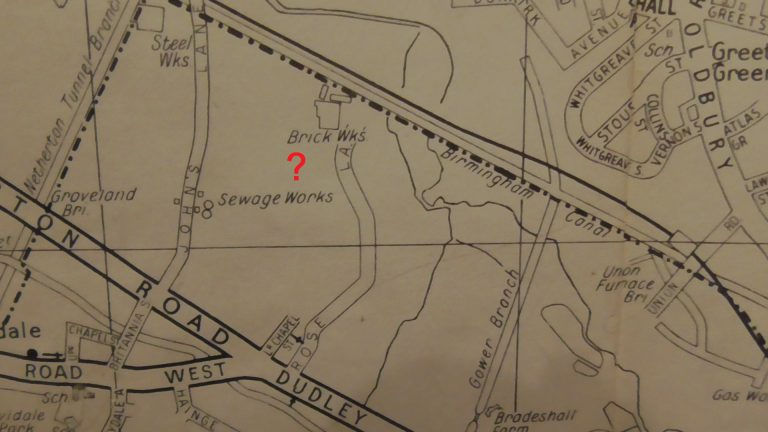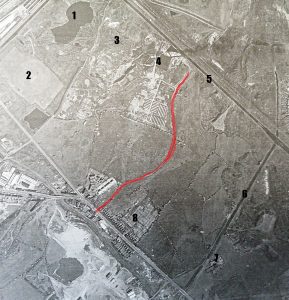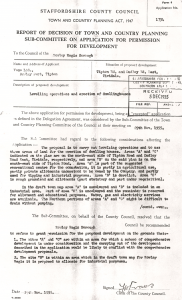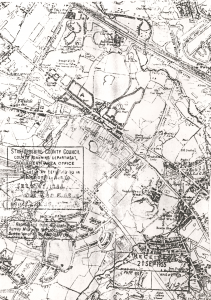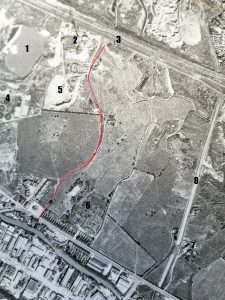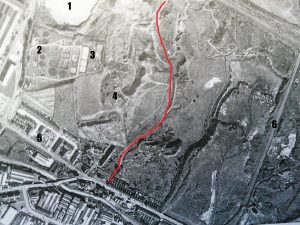This area of land forms quite a complex challenge to describe and also define visually in terms of what it used to be and what it has now become. It is the middle part from which the land changed use from rough animal grazing in the major part, to phased housing development commencing from the 1970’s. It is the tipping part which forms the most controversial aspect. There is a great deal of overlap with land uses and planning applications associated with the rattlechain brickworks and subsequent land sell offs by the conman Sydney Sheldon who trashed the brickworks from the 1960’s onwards. These will be referenced. The physical address of the brickworks itself is listed as being at Rose Lane.
The former Rose Lane ran as a paralleled elbow to John’s Lane on the Eastern side, and from The Dudley Road/Tipton Road across to the aqueduct underneath the Birmingham Mainline Canal and railway line to the North. The wider lands both East and West of this division is in a large area stretching from the East across land to The Gower Branch Canal at one side, with The Dudley and Tipton Roads to the South. West of this was the area of the former Tividale Sewage works, and the Rattlechain brickworks , including the “new” pit dug in the 1950’s which later became the “Duport’s Tip” .
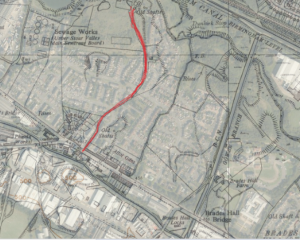
Overlay map of Rose Lane in red from survey map of 1904, showing the extensive “burial” of former agricultural land by housing developments, stretching across the former road.

Panoramic view from 1950 showing Rose Lane marked in red. To the left The Rattlechain brickworks and Rattlechain lagoon, the Tividale sewage works, and bottom left, The Vono Lagoon.
The agricultural lands appear to have been prized by industrial actors for the advantage of their increasingly commercial activities, but also by various local authority projects judging by the planning history. Unfortunately these appear to have conspired in creating tips then housing for mutual benefit, and little environmental gain.
By the end of the second World War , the area West of The Rattlechain brickworks appears to have been largely agricultural grazing land. To The West the industrial concerns of Vono and The Rattlechain brickworks , as well as the Tividale Sewage works are quite definable. A strange barracks type formation is shown to the South of the brickworks, and i am not sure what this is, though maybe stacks of bricks? Only limited housing appears at Lower Chapel Street, off the Tipton and Dudley Roads where Rose Lane starts, and finishes at the aqueduct underneath the Birmingham Canal and railway line. Only the allotments off Dudley Road appear to encroach on the grazing area West of the Lane, which is bounded by the Gower Branch Canal and Mainline canal to the North.
1 Vono lagoon, 2. Vono Sports ground and associated lagoon, 3. Area of Rattlechain brickworks pit (Rattlechain lagoon), 4. Rattlechain brickworks, 5. Birmingham Mainline Canal, 6. Gower Branch Canal, 7. Brades Hall Farm, (Monks Farm), 8. Dudley Road allotments.
Red= rose Lane

Another 1950 view of the undulating land beyond Rose Lane looking towards the Birmingham mainline Canal and The Gower Branch canal
The land is described as “poor” by The Ministry of Agriculture, in a letter concerning a proposed development in 1952. This is obviously a matter of their opinion, but i would say that it appears much more pleasant from this view, than the vile foundry sand dump and punctuated by toxic waste that it became from the early 70’s! This application map numbered 994 shows Rose Lane marked clearly.
I have looked at the planning history for the brickworks site in the 1940/50’s HERE, and the wider Rose Lane area encompasses many of the plans from this era, some of which were never enacted despite being granted permission. Of particular note is application 216, of which there are some references to tipping, but this permission was NEVER a licence to tip across any lands East of Rose Lane, and referred ONLY to the former Rattlechain pit. A map of the site shows the locations of the non actioned 994 and of the 216 application, as well as the extended sewage works sludge drying beds . It is also apparent that the area between the Brades Brook and The Gower Branch canal is proposed as a Tipton college Sports ground.

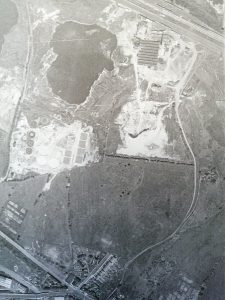
1955, and route of Lane clearly visible on right of picture. Sheldon’s new marlhole has began to carve a visual scar into former agricultural land to the south of the brickworks.
A useful descriptive summary of the lands around Rose Lane is given, in part of a report in 1958
The Vono company, and their successor even more so, (Duport) ,appear to have had a major destructive impact on the areas of land West of Rose Lane. An application 1311 for “the tipping of material at Tipton Road” was granted in 1953.
A further application 1734 “Levelling operations and erection of dwelling houses” came along in 1955. This was originally refused by Rowley Regis Council, citing the fact that it was at odds with the wider scheme for the area. It involved an extension of the carriageway at Dudley Road, and the demise of the allotments with three separate plots of land identified as A, B, and C.
However, at a sub committee meeting of Rowley Regis in April 1956, permission was recommended for approval for area A.
By 1961 the extent of the area can be seen to becoming increasingly overtaken by industrial concerns from The West. The mess of the Rattlechain brickworks new pit is encroaching on the road, the sewage works has expanded to the West also with sludge drying beds, and of course, the Rattlechain lagoon, once one single pit has now acquired a smaller “subsidiary” lagoon carved out by creating a causeway path.
The River Tame from Oldbury is visible, as is the Brades Brook which runs and meets the river. On the right of the Gower branch canal is the Brades Hall Farm, run by the Monk family. Though they owned land on this side to the East of the canal, I am not sure if they ever owned land to the West of this, and the term “Brades Hall Farm” has confusingly referenced the land to the West of the Gower branch in site licences, which I do not believe to be an accurate characterisation of this area.
Aerial photo from 1961, showing the East of Rose Lane as still largely agricultural land, but the blight had began to sweep across from the West.
- Rattlechain lagoon. 2. Rattlechain brickworks. 3. Birmingham Mainline Canal. 4. Tividale Sewage Works. 5. The new Rattlechain brickworks pit that would become “The Duport’s tip”. 6. Dudley Road allotments. 7. Brades Hall farm (Monks farm). 8. The Gower Branch Canal.
Rose Lane in red.
By 1962, the summary of land uses is expressed in an application to turn part of the land into a scrap yard, and concludes that the phosphor bronze company never took up the occupation of the site. But did the crook Sheldon use the part of the permission for tipping as his own commercial free for all? A further application for part of the land bordering the West of Rose Lane was made in 1963 for residential use, but was withdrawn, along with another just months later.
From this point on however the days of brickmaking appear to have been on the wain, and increasingly the authorities appear to have supplemented a very profitable retirement for the Chelmarsh conman along with those other scumbags of the area Vono who were also looking to use the area as a dumping ground for their disgusting company. This 1960’s swindling, I have looked at here, including plans to start building houses off the Tipton Road. Chris Adams recalls memories of what the area around Rose Lane was like here, and how it changed.
It was clear by this picture below from October 1971, that the area had been lost. The landscape resembles carpet bombing, particularly to the West of Rose Lane, and that West of The Brades Brook. The Brades Hall farm also appears derelict and it was around this time that the vile “Monk’s tip” came into being thanks also to the sheisters from British Waterways. Like Sheldon, this family left the area with a vile legacy and it certainly wasn’t pig shit they left behind. The Rattlechain brickworks in this year was virtually destroyed by a fire, and little remained of it thereafter. New houses appear to have been built, Warwick Gardens etc in the area of land that housed the former Tipton Road allotments. (Area A in the 1734 application.
- Rattlechain lagoon. 2 Tividale Sewage Works. 3 Tividale sewage works extension ref 1082 4. The newer Rattlechain brickworks pit that would become “The Duport’s tip”. 5. New houses 6. The Gower Branch canal.
From the early 1970’s onwards vast amounts of unsanctioned tipping of demolition wastes appear to have taken place across the whole area East of Rose Lane, and it disappeared under what became “The Brades Hall tip.” This eventually resulted in a site licence, to continue this agricultural land destruction and then encompassed other subsequent licences, of which areas are looked at elsewhere on this website, with the purposes of building more houses.
Of concern about this site for many years has been the levels of landfill gas associated with these and preceding operations which took place here, some of which were illicit in nature, and in some instances criminal- such as the depositing of poisonous wastes that led to a successful prosecution in 1976.

